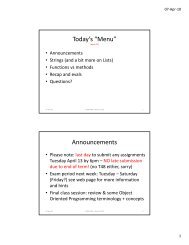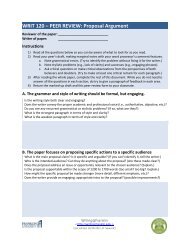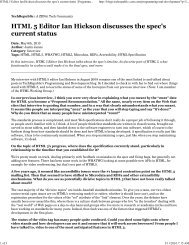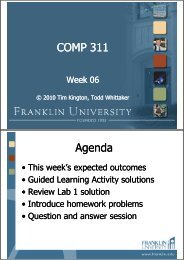FRANKLIN UNIVERSITY PROFICIENCY EXAM (FUPE)
FRANKLIN UNIVERSITY PROFICIENCY EXAM (FUPE)
FRANKLIN UNIVERSITY PROFICIENCY EXAM (FUPE)
You also want an ePaper? Increase the reach of your titles
YUMPU automatically turns print PDFs into web optimized ePapers that Google loves.
<strong>FRANKLIN</strong> <strong>UNIVERSITY</strong> <strong>PROFICIENCY</strong> <strong>EXAM</strong> (<strong>FUPE</strong>)STUDY GUIDECourse Title: Introduction to CS and OOP (COMP 111)Recommended Textbook(s): Big Java, 4 th Edition, Cay Horstmann, Wiley (ISBN: 0-471-69703-6)Number & Type of Questions:Permitted Materials:Time Limit:Approximately 50 questions. The test contains a variety oftypes of questions: multiple choice, true/false, predict theoutput of given code, write code segments to accomplishspecific tasks, fill in the blank, trace an algorithm, shortanswer.Pencil or pen, calculator4 hoursMinimum Passing Score: 80 %Knowledge & Skills Required:The COMP 111 <strong>FUPE</strong> addresses the following weekly course outcomes:Week 11. Use an Integrated Development Environment (IDE) to edit, compile, and run a Javaprogram.2. Employ the feedback from an automatic grading system to correct programdeficiencies.3. Distinguish between and correct syntax and logic errors.4. Describe the inputs, activities, and outputs of each step in the compilation process.Week 25. Distinguish between a data type, an identifier, and a variable.6. Distinguish between objects, classes, and methods.7. Distinguish between inputs and outputs of methods.8. Identify appropriate number types for various kinds of data.9. Use objects, write test cases, and identify and correct program errors.Week 310. Instantiate and use an object from a class.11. Examine how accessor and mutator methods affect objects.12. Create and execute unit tests for pre-written objects.13. Use API documentation to explore object interfaces.14. Explain the differences between a reference and the object it references.1 rev. 06/14/2012
Week 415. Define encapsulation and abstraction in the context of object-oriented programming.16. Apply the principles of encapsulation and abstraction to define the public interface ofa class.17. Implement simple classes and methods.18. Create API documentation for object interfaces.19. Employ a testing framework to validate implemented classes.Week 520. Distinguish between instance fields, local variables, and parameter variables in termsof their use, scope and lifetime.21. Distinguish between implicit and explicit parameters.22. List and describe primitive data types in Java.23. Utilize modifiers static and final to define constants.24. Apply operators and Java library methods to compute arithmetic results.25. Implement classes and methods, write test cases, use String objects, and performsimple I/O.Week 626. List and use common String operations and methods.27. Use the Scanner class for formatted input and the Sytem.out.printf method forformatted output.Week 728. Use if/else statements to implement decisions.29. Apply relational operators to compare numeric data.30. Apply methods to compare strings and objects.31. Write nested if/else statements to implement complex logic.32. Combine logical expressions using Boolean operators.33. Predict the output of code snippets that contain conditionals.34. Use Boolean expressions and operators, selection control structures, and repetitioncontrol structures.35. Select necessary and sufficient test cases.36. Explain black- and white-box testing, regression testing, and test coverage.Week 837. List and describe the four components of all loops.38. Use for, while, and do loops to solve simple problems.39. Identify and correct common loop errors such as off-by-one errors, infinite loops,and non-executing loops.40. Predict the output of code snippets that contain loops.41. Implement algorithms requiring nested loops.42. Differentiate between various loop termination conditions such as sentinels,symmetric and asymmetric bounds, and counting.Week 943. Use the basic methods of the Random class to generate random numbers.44. Use a debugger to examine a running program.45. Describe the properties and uses of arrays and ArrayList data structures.46. Use arrays and ArrayLists and advanced loop processing.2 rev. 06/14/2012
Week 1047. Compare and contrast the properties and uses of primitive data types versuswrapper classes.48. Apply the generalized for loop to simple array algorithms.49. Declare, instantiate, initialize, and use multi-dimensional arrays.50. Write code snippets to copy, insert, and delete elements of arrays.Week 1151. Identify and defend good candidates for classes and methods.52. Design classes to reduce coupling, increase cohesion, and minimize side effects.53. Apply advanced array processing algorithms, good class design principles, andproblem solving techniques.Week 1254. Compare, contrast, and demonstrate the execution of algorithms for selection,insertion, and bubble sorts.55. Analyze the performance of selection, insertion, and bubble sorts using profile dataand primitive operation counts.56. Compare, contrast, and demonstrate the execution of the algorithms for linear andbinary search.57. Analyze the performance of linear and binary search using profile data and primitiveoperation counts.Week 1358. Specify the pre- and post-conditions for a method.59. Differentiate between the uses of static and non-static fields and methods in aclass.60. Determine the scope of a variable.61. Use packages to group related classes.Week 1462. Apply previous learning outcomes to design a problem solution involving multipledependent classes.63. Create an object-oriented design of several classes, complete with UML diagram,attributes (description of instance data), and behaviors (methods).3 rev. 06/14/2012











